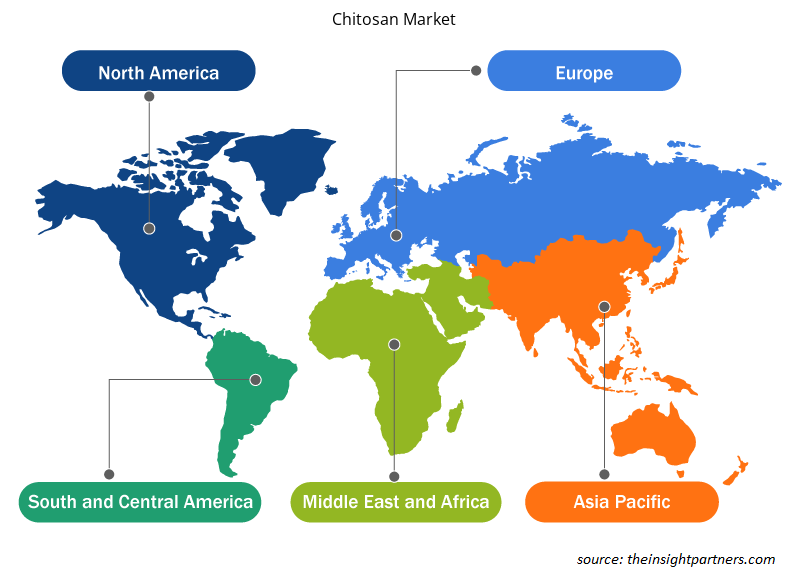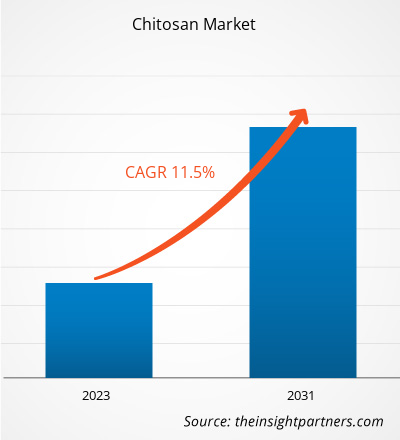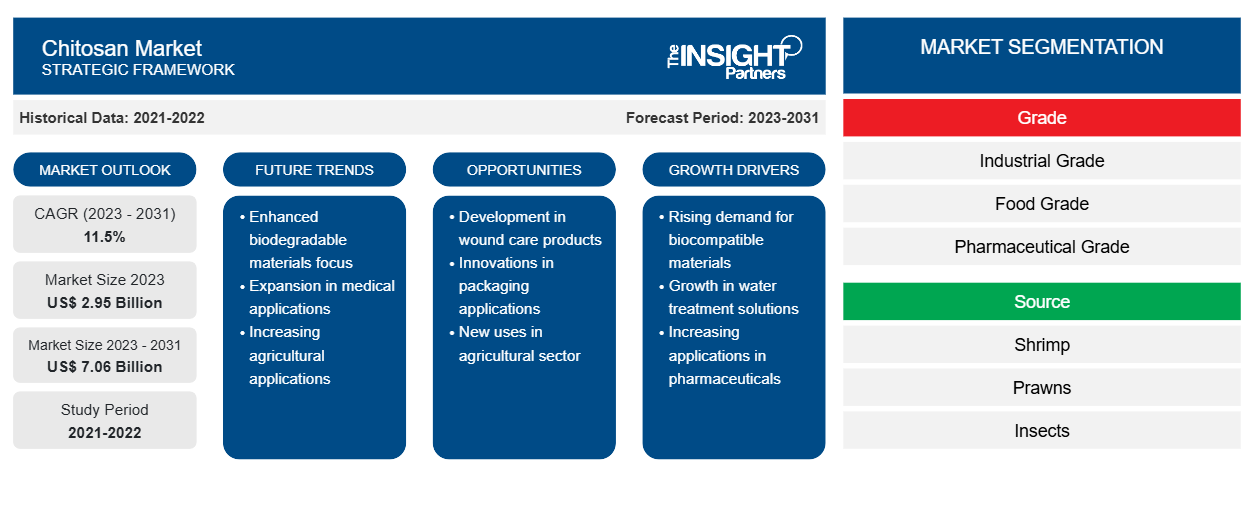Se proyecta que el tamaño del mercado de quitosano alcance los 7.060 millones de dólares en 2031, frente a los 2.950 millones de dólares en 2023. Se espera que el mercado registre una CAGR del 11,5 % entre 2023 y 2031. Es probable que la creciente demanda de alternativas ecológicas en las industrias de uso final siga siendo una tendencia clave en el mercado del quitosano.CAGR of 11.5% in 2023–2031. Growing demand for eco-friendly alternatives across the end-use industries, is likely to remain key chitosan market trends.
Análisis del mercado del quitosano
La multifuncionalidad del quitosano y su creciente aplicación en la industria cosmética han contribuido al crecimiento del mercado del quitosano. Se lo reconoce como un biomaterial versátil debido a su no toxicidad, baja alergenicidad, biodegradabilidad y biocompatibilidad. Debido a estas propiedades, se utiliza en una amplia gama de aplicaciones, como alimentos y bebidas, tratamiento de agua, productos médicos y farmacéuticos, cosméticos y agroquímicos. Debido a su propiedad tangible de adsorción, el quitosano ha encontrado un lugar importante en la aplicación de tratamiento de agua para adsorber metales, hierro, sustancias tóxicas y otras impurezas de las aguas residuales. El quitosano y sus derivados catiónicos tienen el potencial de interactuar con la queratina para formar películas transparentes y elásticas sobre el cabello. Estas películas ayudan a aumentar la fuerza y la suavidad del cabello y evitan que se dañe. Con la creciente demanda de productos para el cuidado del cabello, se estima que la aplicación de quitosano en productos para el cuidado del cabello impulsará el mercado en todo el mundo. Se ha estimado que la aplicación de quitosano en productos para el cuidado del cabello y cosméticos está creciendo a un ritmo rápido y contribuirá a la expansión y el desarrollo del mercado de quitosano en todo el mundo.biomaterial due to its non-toxicity, low allergenicity, biodegradability, and biocompatibility. Owing to these properties, it is used in a wide range of applications such as food & beverages, water treatment, medical & pharmaceuticals, cosmetics, and agrochemicals. Due to its tangible property of adsorption, chitosan has found a profound place in the water treatment application to adsorb metals, iron, toxic substances, and other impurities from the wastewater. Chitosan and its cationic derivatives have the potential to interact with keratin to form transparent, elastic films over hair. These films help in increasing hair strength, hair softness, and avoid hair damage. With the increasing demand for hair care products, the application of chitosan in productshaircare and cosmetic products is estimated to be growing at a swift pace and will contribute to the expansion and development of the chitosan market all over the globe.
Descripción general del mercado del quitosano
El quitosano es un polisacárido biocompatible y biodegradable, derivado naturalmente de la desacetilación de la quitina, que se encuentra en el exoesqueleto de crustáceos e insectos. Los grupos funcionales presentes en el quitosano afectan significativamente sus propiedades, como la actividad antimicrobiana, la estabilidad del pH, la naturaleza catiónica y la mucoadhesión. El quitosano está disponible en varias formas, como nanofibras, nanopartículas, nanocompuestos, perlas de quitosano y películas de quitosano. El quitosano se utiliza ampliamente en el sector farmacéutico y biomédico. Además, el quitosano es objeto de una gran investigación para el desarrollo de biomateriales y sistemas para la ingeniería de tejidos y el desarrollo de fármacos.biocompatible and biodegradable polysaccharide, naturally derived from deacetylation of chitin, found in exoskeleton of crustacean and insects. Functional groups present in chitosan significantly impact its properties such as anti-microbial activity, pH stability, cationic nature, and mucoadhesion. Chitosan is available in various forms such as nanofibers, nanoparticles, nanocomposites, chitosan beads, and chitosan films. Chitosan is extensively used in pharmaceutical and biomedical sector. Furthermore, chitosan is highly researched for development of biomaterials and systems for tissue engineering and drugs development.
Personalice este informe según sus necesidades
Obtendrá personalización en cualquier informe, sin cargo, incluidas partes de este informe o análisis a nivel de país, paquete de datos de Excel, así como también grandes ofertas y descuentos para empresas emergentes y universidades.
-
Obtenga las principales tendencias clave del mercado de este informe.Esta muestra GRATUITA incluirá análisis de datos, desde tendencias del mercado hasta estimaciones y pronósticos.
Factores impulsores y oportunidades del mercado del quitosano
Creciente aplicación de quitosano en la industria cosmética favorece el mercado
El creciente énfasis en los bioingredientes y la transición de la industria cosmética hacia la cosmética ecológica, respaldada por regulaciones internacionales, impulsan la demanda de quitosano. El quitosano y sus derivados ofrecen propiedades fisicoquímicas y biológicas para la formulación de productos cosméticos. Uno de los beneficios esenciales del quitosano en la industria cosmética es su utilización como agente humectante para mantener la piel hidratada y nutrida. El quitosano se utiliza para prevenir la sequedad de la piel inducida por los rayos UV, la hiperplasia epidérmica y la formación de arrugas. La creciente aplicación del quitosano en la industria cosmética es uno de los principales impulsores de la participación de mercado global del quitosano.bioingredients and the transition of cosmetics industry towards green cosmetics supported by international regulations drive the demand for chitosan. Chitosan and its derivatives offer physicochemical and biological properties for formulating cosmetic products. One of the essential benefits of chitosan in the cosmetics industry is its utilization as a moisturizing agent to keep the skin hydrated and nourished. Chitosan is used in prevention of UV-induced skin dryness, epidermal hyperplasia, and wrinkle formation. The growing application of chitosan in the
Adopción de quitosano para el desarrollo de nanocompuestos: una oportunidad en el mercado del quitosanoNanocomposites – An Opportunity in Chitosan Market
Los nanocompuestos a base de quitosano ofrecen varias propiedades, como una mejor resistencia mecánica, estabilidad térmica, propiedades de barrera y otras funcionalidades, lo que los hace adecuados para una amplia gama de aplicaciones. Los nanocompuestos a base de quitosano se utilizan en aplicaciones agrícolas para fertilizantes y pesticidas de liberación controlada. Se utiliza para mejorar el crecimiento de las plantas y proteger contra patógenos. También se utiliza como material activo para el envasado de alimentos. Por lo tanto, se espera que la adopción del quitosano para el desarrollo de nanocompuestos tenga un impacto positivo en el mercado del quitosano.nanocomposites offer several properties such as improved mechanical strength, thermal stability, barrier properties and other functionalities, making them suitable for broad application range. Chitosan-based nanocomposites are used in agricultural applications for controlled release fertilizers and pesticides. It is used to enhance plant growth and protect against pathogens. It is also used as the active food packaging material. Thus, adoption of chitosan for development of nanocomposites is expected to have a positive impact on the chitosan market.
Informe de mercado de quitosano Análisis de segmentación
Los segmentos clave que contribuyeron a la derivación del análisis del mercado de quitosano son el grado, la fuente y la aplicación.
- Según el grado, el mercado del quitosano se divide en grado industrial, grado alimenticio y grado farmacéutico. El segmento de grado industrial tuvo una mayor participación de mercado en 2023.
- Por origen, el mercado está segmentado en camarones, langostinos, insectos, cangrejos y otros. El segmento de camarones tuvo la mayor participación del mercado en 2023.
- En términos de aplicación, el mercado se clasifica en tratamiento de agua, alimentos y bebidas, biomedicina y productos farmacéuticos, cosméticos y otros. El segmento de tratamiento de agua dominó el mercado en 2023.
Análisis de la cuota de mercado del quitosano por geografía
El alcance geográfico del informe del mercado de quitosano se divide principalmente en cinco regiones: América del Norte, Asia Pacífico, Europa, Medio Oriente y África, y América del Sur / América del Sur y Central.
La región de Asia Pacífico ha dominado el mercado del quitosano. Factores como el rápido desarrollo de industrias de uso final como el tratamiento de agua, alimentos y bebidas, productos biomédicos y farmacéuticos y cosméticos en Japón, China, India y Corea del Sur están impulsando la demanda de quitosano en la región de Asia Pacífico. Por ejemplo, productos como la glucosamina y los oligosacáridos de quitosano se consideran seguros para su uso en suplementos dietéticos, según la Administración de Alimentos y Medicamentos de Corea. Asimismo, en Japón, está registrado en los aditivos alimentarios en la lista proporcionada por la Fundación de Investigación Química de Alimentos de Japón. La creciente demanda de quitosano en la región de Asia Pacífico se debe principalmente al tratamiento de agua, alimentos y bebidas y aplicaciones farmacéuticas. También se espera que la creciente demanda de la fabricación de piel artificial y en apósitos para heridas tenga un impacto positivo en el crecimiento del mercado del quitosano en la región de Asia Pacífico.
Perspectivas regionales del mercado del quitosano
Los analistas de Insight Partners explicaron en detalle las tendencias y los factores regionales que influyen en el mercado del quitosano durante el período de pronóstico. En esta sección también se analizan los segmentos y la geografía del mercado del quitosano en América del Norte, Europa, Asia Pacífico, Oriente Medio y África, y América del Sur y Central.

- Obtenga los datos regionales específicos para el mercado de quitosano
Alcance del informe de mercado de quitosano
| Atributo del informe | Detalles |
|---|---|
| Tamaño del mercado en 2023 | US$ 2.95 mil millones |
| Tamaño del mercado en 2031 | US$ 7.06 mil millones |
| CAGR global (2023 - 2031) | 11,5% |
| Datos históricos | 2021-2022 |
| Período de pronóstico | 2023-2031 |
| Segmentos cubiertos |
Por grado
|
| Regiones y países cubiertos |
América del norte
|
| Líderes del mercado y perfiles de empresas clave |
|
Densidad de actores del mercado: comprensión de su impacto en la dinámica empresarial
El mercado del quitosano está creciendo rápidamente, impulsado por la creciente demanda de los usuarios finales debido a factores como la evolución de las preferencias de los consumidores, los avances tecnológicos y una mayor conciencia de los beneficios del producto. A medida que aumenta la demanda, las empresas amplían sus ofertas, innovan para satisfacer las necesidades de los consumidores y aprovechan las tendencias emergentes, lo que impulsa aún más el crecimiento del mercado.
La densidad de actores del mercado se refiere a la distribución de las empresas o firmas que operan dentro de un mercado o industria en particular. Indica cuántos competidores (actores del mercado) están presentes en un espacio de mercado determinado en relación con su tamaño o valor total de mercado.
Las principales empresas que operan en el mercado del quitosano son:
- KitoSano SL
- Biopolímeros avanzados AS
- Corporación FMC
- Corporación Bio GTC
- Productos farmacéuticos Golden-Shell
- Heppe Medical Chitosan GmbH
Descargo de responsabilidad : Las empresas enumeradas anteriormente no están clasificadas en ningún orden particular.

- Obtenga una descripción general de los principales actores clave del mercado de quitosano
Noticias y desarrollos recientes del mercado del quitosano
El mercado del quitosano se evalúa mediante la recopilación de datos cualitativos y cuantitativos a partir de investigaciones primarias y secundarias, que incluyen publicaciones corporativas importantes, datos de asociaciones y bases de datos. A continuación, se incluye una lista de los avances en el mercado en cuanto a innovaciones, expansión comercial y estrategias:
- En marzo de 2023, Heppe Medical Chitosan GmbH desarrolló una nueva tecnología de quitosano para la liberación eficiente de principios activos de ARNm. La tecnología tiene como objetivo garantizar que los medicamentos para el tratamiento de enfermedades graves puedan ser mejor absorbidos y procesados por el organismo. (Fuente: Heppe Medical Chitosan GmbH, nota de prensa)
- En marzo de 2023, los investigadores de la Universidad de Stuttgart desarrollaron un material compuesto ecológico a partir de lino y quitosano. (Fuente: Universidad de Stuttgart, Boletín informativo)
- En noviembre de 2022, Alpha Chitin y Novochizol SA anunciaron una empresa conjunta para producir un polisacárido a base de quitosano. (Fuente: Novochizol SA, comunicado de prensa)
Informe de mercado sobre quitosano: cobertura y resultados
El informe “Tamaño y pronóstico del mercado de quitosano (2021-2031)” proporciona un análisis detallado del mercado que cubre las siguientes áreas:
- Tamaño del mercado y pronóstico a nivel global, regional y nacional para todos los segmentos clave del mercado cubiertos bajo el alcance
- Dinámica del mercado, como impulsores, restricciones y oportunidades clave
- Principales tendencias futuras
- Análisis detallado de las cinco fuerzas de Porter y PEST y FODA
- Análisis del mercado global y regional que cubre las tendencias clave del mercado, los principales actores, las regulaciones y los desarrollos recientes del mercado.
- Análisis del panorama de la industria y de la competencia que abarca la concentración del mercado, el análisis de mapas de calor, los actores destacados y los desarrollos recientes
- Perfiles detallados de empresas
- Análisis histórico (2 años), año base, pronóstico (7 años) con CAGR
- Análisis PEST y FODA
- Tamaño del mercado, valor/volumen: global, regional y nacional
- Industria y panorama competitivo
- Conjunto de datos de Excel
Informes recientes
Testimonios
Razón para comprar
- Toma de decisiones informada
- Comprensión de la dinámica del mercado
- Análisis competitivo
- Información sobre clientes
- Pronósticos del mercado
- Mitigación de riesgos
- Planificación estratégica
- Justificación de la inversión
- Identificación de mercados emergentes
- Mejora de las estrategias de marketing
- Impulso de la eficiencia operativa
- Alineación con las tendencias regulatorias























 Obtenga una muestra gratuita para - Mercado de quitosano
Obtenga una muestra gratuita para - Mercado de quitosano